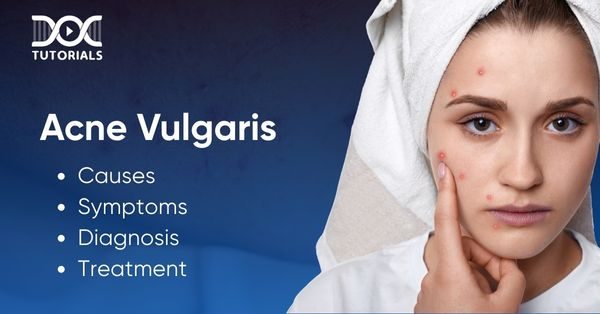Acne Vulgaris: Causes, Symptoms, Diagnosis, and Treatment

Acne vulgaris is the 8th most prevalent disease globally and affects about 9.4 % of the worldwide population. It develops when oil and dead cells block hair follicles, causing whiteheads, blackheads, pimples, and deeper lumps under the skin, usually on the face, chest, and back.
Generally, acne develops in puberty through hormonal changes but can remain through adulthood and dramatically interfere with the quality of life through physical (through pain) and psychological distress. Effective management of acne requires an understanding of its multifactorial nature and often a combination of topical treatments, oral medications, and lifestyle modifications.
Continue reading to understand the possible causes and risk factors, common symptoms and diagnostic criteria, and comprehensive treatment of acne vulgaris.
What is Acne Vulgaris?
Acne vulgaris is a widespread skin disease caused by obstruction of hair follicles caused by a mix of sebum (oil), dead skin cells, and bacteria. These bacteria become the breeding ground for Cutibacterium acnes, causing an inflammatory response.
Acne mostly occurs on the face, chest, and back, where oil glands are concentrated. It is also referred to as ‘pimples,’ ‘spots,’ and even ‘zits,’ but it can take many forms, including blackheads, whiteheads, papules, or cysts. This condition usually occurs during puberty when the body produces excess sebum due to the increased levels of dehydroepiandrosterone in the body.
Acne, however, can persist or appear in adulthood. It differs from other skin conditions in that it presents inflammatory and noninflammatory lesions (comedones), and this mixed clinical picture ranges in severity from person to person.
This dual nature of acne vulgaris—both inflammatory and non-inflammatory—accounts for the specific and, necessarily, multifaceted approach to acne vulgaris treatment, which attacks both types of lesions at once.
Causes of Acne Vulgaris
There are several causes that partake in the development of acne vulgaris. However, there are 4 key pathophysiological processes that converge to establish the primary event of acne vulgaris:
- Hyperactive Sebaceous Glands
Hyperactive sebaceous glands produce excessive oil, often triggered by the fluctuation of androgens, such as testosterone and dihydrotestosterone (DHT).
- Follicular Plugging
This occurs due to abnormal Keratinocyte Proliferation (Irregular shedding of dead skin cells (hyperkeratinisation), leading to follicular plugging, which creates the ideal environment for bacterial growth.
- Bacterial Colonization
Cutibacterium acnes bacteria commonly found on skin proliferate in the oxygen-poor lipid-rich environment of blocked follicles, which triggers inflammatory responses.
- Inflammation
Bacterial overgrowth and follicular disruption result in an immune system response, which causes inflammation (redness, swelling, and discomfort) associated with inflammatory acne lesions.
Risk Factors of Acne Vulgaris
Here’s a breakdown of the risk factors that majorly contribute to the disease:
- Genetic Predisposition
Family history is the most significant risk factor for acne, as studies suggest that up to 80% of severe forms have a genetic basis. Sebum production rates, follicular keratinisation patterns, and inflammatory response tendencies are genetically determined, predisposing some people to develop acne.
- Hormonal Influences
Hormonal fluctuations during puberty, menstruation, pregnancy, and conditions like PCOS (Polycystic Ovary Syndrome) trigger sebaceous gland hyperactivity. In particular, androgens spur sebum production, and endocrine disorders are usually accompanied by acne as a primary symptom.
- Dietary Factors
High-glycemic foods spike insulin levels, leading to more sebum production and inflammation. Skim milk and other dairy products are consistently linked to the development of acne based on hormone and growth factor pathways that stimulate oil glands and promote inflammation.
- External Factors
Occlusive cosmetics, mechanical friction (for example, from the edge or back of helmets and phones), environmental conditions like humidity and pollution, and some medications (corticosteroids, lithium, etc.) have been shown to block pores or disrupt skin homeostasis enough to worsen acne or provoke it.
- Psychological Factors
Cortisol elevated from chronic stress and inflammatory neuropeptide release can stimulate the sebaceous gland. This means that psychological distress is linked to acne severity in a bidirectional manner and vice versa.
Symptoms of Acne Vulgaris
The symptoms of acne vulgaris mainly comprise a spectrum of characteristic lesions of acne vulgaris, ranging from mild to severe:
- Non-inflammatory Lesions (Comedonal Acne)
- Closed comedones (whiteheads) are small, flesh-coloured bumps containing sebum and dead skin cells trapped under an intact skin surface.
- Dilated follicles with oxidised melanin and sebum, hence the characteristic dark appearance, open comedones (blackheads)
- Inflammatory Lesions
- Papules: Small (less than 5mm), tender, red bumps on the skin’s surface that indicate inflammation within the follicle (papules).
- Pustules: Papules covered with transparent or yellow pus with a red ring around them
- Nodules: Larger (longer than 5 mm), firm, painful lesions deep within the dermis.
- Cysts: Deep, fluid-filled, painful scars that can lead to a lot of scarring sebaceous glands concentrate in the face (99% cases), back (60%), chest (15%), and shoulders (15%), where acne is most common.
Beyond physical symptoms, acne has a tremendous negative psychological impact, causing social anxiety, depression, and poor quality of life, especially in adolescents and young adults.
Diagnosis of Acne Vulgaris
- Clinical Assessment
The diagnosis of acne vulgaris is based chiefly on identifying lesions’ characteristic appearance and distribution on visual examination. A physician’s exam would focus on the medical history (onset and duration, exacerbating factors, previous treatments) and family history. For women, evaluation of potential hormonal roles, particularly in the case of menstrual irregularities, hirsutism, and adult-onset acne, is necessary.
- Severity Classification
Acne is classified as mild if it is primarily comedonal with few inflammatory lesions, moderate if many papules and pustules are present with some nodules, and severe if there are several inflammatory lesions, nodules, and even potential scarring. The treatment approach is based on this classification and allows for the monitoring of therapeutic response.
- Differential Diagnosis
Acne needs to be distinguished from other similar-appearing conditions to make a proper diagnosis. Patients with rosacea (lacking comedones and persistent facial erythema), folliculitis (of bacterial or fungal origin), perioral dermatitis (papules prominent around the mouth but without comedones), and drug-induced acne (monomorphic eruptions due to medications such as corticosteroids, lithium, or anticonvulsants) are included.
Laboratory testing rarely plays a role in routine acne diagnosis, except in exceptional circumstances when an endocrine disorder may be suspected and thus necessitate workup with blood tests to evaluate hormones.
Treatment Options for Acne Vulgaris
- Topical Treatments
- Benzoyl Peroxide: Benzoyl Peroxide kills acne-causing bacteria and alleviates inflammation. It is available in different strengths (2.5-10%) and is effective against mild to moderate acne but may cause dryness and irritation.
- Topical Retinoids: Vitamin A derivatives (tretinoin, adapalene, tazarotene) prevent pore blocking by normalising skin cell turnover (topical retinoids). They are particularly effective for comedonal acne and do initially cause irritation and increased sun sensitivity.
- Topical Antibiotics: Clindamycin and erythromycin are topical antibiotics which reduce bacterial colonisation and inflammation. However, due to resistance issues, they are now only recommended in combination with benzoyl peroxide, not separately.
- Salicylic Acid: Salicylic Acid exfoliates the skin and opens the blocked pores by breaking down the corralling of dead skin cells. It is effective for blackheads and whiteheads and has barely any side effects.
- Azelaic Acid: This option is beneficial for sensitive skin, particularly for treating post-inflammatory hyperpigmentation, as it is antimicrobial and anti-inflammatory.
Systemic Treatments
- Oral Antibiotics: Tetracyclines and macrolides are oral antibiotics targeted for moderate to severe inflammatory acne because of their antimicrobial and anti-inflammatory effects. Treatment should last from 3 to 6 months to decrease antibiotic resistance.
- Hormonal Therapy: Hormonal acne is treated with combined oral contraceptives and spironolactone to lower androgen effects on oil glands. Women with lower face or jawline acne or premenstrual flares are exceptionally responsive to these.
- Isotretinoin: There are some drastic forms of treatment for severe, resistant acne, one of the strongest being isotretinoin, an extremely powerful oral retinoid that reduces sebum production. However, its high efficacy constitutes a significant drawback since it has serious side effects requiring monitoring.
Adjunctive Treatments
- Procedural Interventions: Corticosteroid injections, peels, light therapy, and lasers quickly treat painful cysts, and they complement traditional treatments, particularly for acne scarring.
- Lifestyle Modifications: There is evidence that low-glycemic diets, stress management, and appropriate skin care may improve medical treatment outcomes.
FAQs about Acne Vulgaris
- For how many days does the acne vulgaris last?
Acne lesions generally disappear within two weeks, but deep papules and nodules can last for months. Oily skin (seborrhoea) is also common in many acne patients.
- Can acne vulgaris be transmitted?
Acne vulgaris is non-contagious. Therefore, close contact with others is considered safe.
- What is there between acne and acne vulgaris?
The terms ‘acne’ and ‘acne vulgaris’ are essentially synonyms; ‘acne vulgaris’ is the medical or scientific term for acne – a skin condition involving clogged pores and the common types of such breakouts as pimples.
- Which is the hormone causing acne vulgaris?
The major hormones associated with acne vulgaris are androgens, most notably dihydrotestosterone (DHT) and testosterone, which promote the production of sebum and sebum gland activity.
- Is the acne vulgaris a fungal infection or bacterial?
Although both can lead to acne breakouts, typical acne (acne vulgaris) is due to clogged pores and possible bacteria, while fungal acne (pityrosporum folliculitis) is a yeast (Malassezia) infection.
Conclusion
Acne vulgaris is the most common type of acne. Early intervention remains essential to prevent scarring and psychological impact from the disease because there are systemic medications for everything from topical therapies to severe presentations and from mild cases to topical treatments.
DocTutorials is your single-point solution for education about several diseases and contributing to NEET PG preparation. Our platform enables students to access expert video lectures, test series, question banks, and examination guidance, elevating medical education.
Latest Blogs
-

NEET SS Exam 2024: Analysis, Key Dates, Counselling
The NEET SS 2024 exam kicked off on March 29, 2025. Over two days and two slots, candidates across 13…
-

NEET PG Registration 2025: An Essential Guide For Exam Prep
The NEET PG registration, which is conducted online, is a crucial step in the exam process. Filling out the NEET…
-

NEET PG Syllabus 2026: A Must-Have Complete Guide for Exam Success
The NEET PG Syllabus acts as one of the foundation stones for aspiring postgraduate medical students like you who are…




